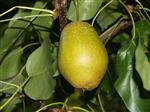Pear -Pyrus
 There are approximately 20 species of Pyrus; and many varieties of deciduous trees with pear-shaped fruits, including ornamental species as well as others grown for their edible fruit. They often have attractive gold to orange autumn foliage. Blossom in late winter or early spring can cover the tree and also be very attractive.
There are approximately 20 species of Pyrus; and many varieties of deciduous trees with pear-shaped fruits, including ornamental species as well as others grown for their edible fruit. They often have attractive gold to orange autumn foliage. Blossom in late winter or early spring can cover the tree and also be very attractive.
They thrive in full sun, and are adaptable as to soils. They generally like similar treatment to Malus (Apple), but are often a little hardier than apples. See Malus for cultural details – their culture is virtually the same as apples.
Pear Cultivars
There are many named cultivars, most growing to around 5 or 6 metres tall; but occasionally some will grow much taller. While they are mostly varieties bred and grown for edible fruit; some have been developed as ornamental plants, grown for their blossom, colourful fruits and autumn foliage.
FRUITING PEAR (Pyrus communis)
Pears are a pome fruit related to the apple. Pears require a similar climate and soil to apples but their flowers are more tender than apples, and the fruit more prone to wind damage. Deficiencies of manganese, boron and copper sometimes occur. Most varieties need cross pollination. Prune the same as for the apple, but not as heavy (heavy pruning encourages vigorous regrowth and reduces fruiting). Fruit thinning is normally required.
Common problems include San Jose Scale and some of the insects that also affect apples, Pear Leaf Mite, Pear & Cherry Slug, Pear Scab, Blossom Blight and Stony Pit Virus
NASHI or ASIAN PEAR (Pyrus pyrifolia X P. ussuriensis)
Generally speaking, Nashi will grow and produce where other pears flourish although the winter chilling requirement is less (ie: It grows in warmer areas). High rainfall close to harvest can cause fruit to split. Reasonably fertile, deep, well drained soils are needed (pH 6.5). Cross pollination is strongly recommended and therefore plant at least two different varieties. Protection from wind is also very important. Trees should be planted 4‑5m apart and trained with one main central trunk. Under good growing conditions and adequate cross pollination, Nashi will produce an abundance of fruit. Thinning is needed to get reasonable size fruit. Nashi suffer the same pest and disease problems as standard pears although it seems to have resistance to scab. Routine spraying is needed to get pest and disease free fruit. Birds can be a problem also. Fruit are harvested carefully when they turn yellow.
Learn More about Plants through an ACS Plant Variety course.
Click for details: http://www.hortcourses.com/courses/product_listings.aspx?catid=Plant+Varieties
For Australian Native Plants, Click here http://www.hortcourses.com/courses/product_listings.aspx?catid=Australian+Native+Plants
You may also be interested in....